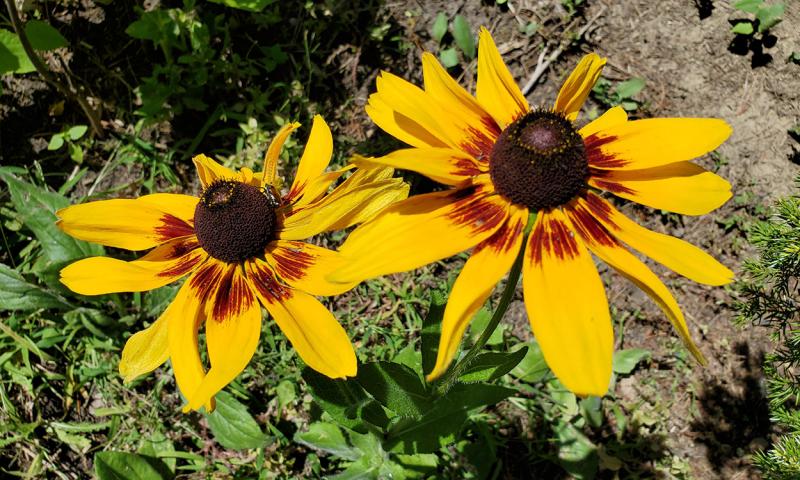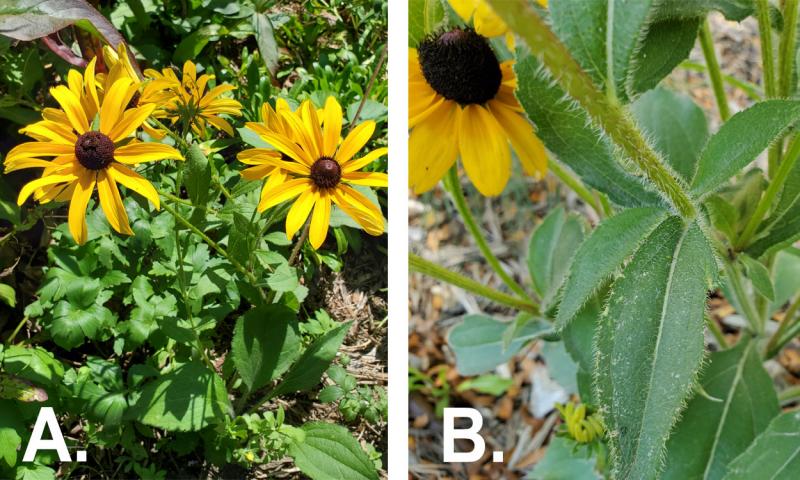
Original article by David Graper, former SDSU Extension Horticulture Specialist and Master Gardener Program Coordinator. Updated by Kristine Lang, Assistant Professor and SDSU Extension Consumer Horticulture Specialist.
Rudbeckia, or Black-Eyed Susans, are a favorite plant of many gardeners. They are prized for their bright yellow-to-orange flowers with the dark-brown center that are borne in abundance from early summer until a hard freeze (Figure 1).
Rudbeckias are typically easy to grow when planted in a sunny location. There are many different types to choose from, but two of the most-common varieties are Rudbeckia hirta and Rudbeckia fulgida.
Rudbeckia hirta

R. hirta is the most common type of Black-Eyed Susan. The typical plant grows 14 to 24 inches tall with fairly large yellow-to-orange flowers with a raised, dark brown, central “cone”(Figure 2-A). Some flowers will also have dark-brown patches on the flower petals near the central cone. There are dozens of different varieties of R. hirta with a wide variation in flower color, ranging from the typical yellow to dark-brown or red and with central cones that might be dark-brown or green. Some varieties may also have single or double flowers. Height can vary quite a bit too, depending on the variety. Some only grow about a foot tall, while others may reach close to 30 inches. Both the leaves and stems are covered by short bristly hairs that give them a rough-feeling texture (Figure 2-B).
Many gardeners believe R. hirta to be perennials, but, in fact, most of these annual plants do not survive our winters. Rather, new plants grow up from seed that was dropped by plants the previous year, making it appear that they are perennial. So, plant R. hirta in the spring, but don’t be surprised if the plants appear in slightly different locations, or if the flower color changes a bit, as the offspring from a hybrid will not often come back looking the same as the parent. If you deadhead R. hirta, this might improve the appearance of your plants, but also reduce the chance of the plants making it through the winter. Skip the last deadheading pass and allow R. hirta to set and drop seed instead.
Rudbeckia fulgida

R. fulgida is a hardy perennial in South Dakota that spreads by rhizomes versus dropping seeds. The flowers of R. fulgida are usually smaller but more numerous than those of R. hirta (Figure 3-A). Flowering begins in July and continues all summer into the early fall. The most commonly planted cultivar is called R. fulgida var. sullivantii ‘Goldsturm.’ It has bright-yellow flowers with the dark brown cone. Perennial R. fulgida is becoming more popular in the garden due to its heat and drought tolerance in addition to its beautiful floral display.
In two to three years, the R. fulgida will form a nice, large clump in the garden with a more-mounded growth habit than R. hirta. The leaves of R. fulgida are usually more rounded in appearance, especially near the base of the plant, and the stem and leaves are less hairy than those of R. hirta (Figure 3-B).
Pests and Diseases
Rudbeckias are, in general, relatively free of pest problems. The plants may experience an occasional aphid infestation. Some Rudbeckias are especially susceptible to powdery mildew, although this is more damaging to plant appearance than its ability to survive and reproduce.
Aster Yellows is a disease that can be severe in Rudbeckia, as well as any plant in the Aster family and other plants. It is caused by an organism called a phytoplasma and is spread by leaf hoppers. Once a plant gets the disease, there is no treatment for it, except to pull out the plant before the disease has a chance to spread to other plants. The most common symptoms are flowers that turn green and even have leafy shoots developing in place of petals. The plants will also be stunted and have a yellowish appearance.
Special thanks to SDSU Extension Master Gardeners Tim Schreiner and Stacy Dreis for serving as volunteer copyeditors of this article.


